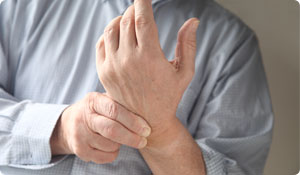
Ganglion cysts (ganglion means knot) are non-cancerous lumps that usually develop along the tendons or joints of the wrists, hands, ankles, or feet. They are filled with a thick, clear, mucous-like fluid and resemble a water balloon at the end of a stalk. Ganglion cysts do not spread.
In earlier times, people believed the devil caused ganglion cysts so they smashed them with a bible to make them rupture and drain into surrounding tissues. That's why you'll hear them sometimes referred to as Bible cysts, or Gideon's disease, after the popular "treatment." Today, we know that smashing a ganglion cyst is not the best way to treat it.
Sixty percent of benign hand tumors are ganglion cysts. They usually form on the top of the wrist (dorsal ganglion) at the joint of the wrist on the thumb side. They may also form at the end or base of a finger, or on the underside of the wrist between your thumb and pulse point. When ganglion cysts affect joints, they can cause joint instability, weakness, and limited movement.
Physicians are not entirely sure why ganglion cysts form. One theory is that the mucus-like connective tissue (collagen) degenerates.
Who's at Risk for Ganglion Cysts
Anyone can develop a ganglion cyst; however, women, especially those between 20 and 30, are three times more likely to develop them. Individuals with arthritis in the finger joints closest to the fingernails, or those who have joint or tendon injuries are also at greater risk. Ganglion cysts are common in gymnasts due to repeated stress on their wrists.
How to Treat a Ganglion Cyst
The good news is that ganglion cysts often disappear without treatment. You may need an over-the-counter pain-reliever if you experience temporary aches or pains. If the cyst causes tingling or burning, it may be touching a nerve, and a dull ache or pain may indicate the cyst is pressing against a tendon or joint.
For ganglion cysts that cause problems, or are unsightly, there are several possible remedies:
- Immobilizing the hand or foot to relieve repeated stress may help it heal.
- Your physician can aspirate (drain the fluid) with a small needle.
- Shoe modifications may relieve discomfort caused by foot cysts.
- You can also have your ganglion cyst surgically removed.
Ganglion cysts may come back, although the recurrence rate is lower in people who have surgery.
Craig Kraffert, MD, reviewed this article.
Sources:
Mayo Clinic. "Ganglion Cysts." Web. 8 January 2013.
http://www.mayoclinic.com/health/ganglion-cysts/DS00767
American Academy of Orthopaedic Surgeons. "Ganglion (Cyst) of the Wrist." Web. October 2007.
http://orthoinfo.aaos.org/topic.cfm?topic=A00006
American Society for Surgery of the Hand. "Ganglion Cysts." Web.
http://www.assh.org/Public/HandConditions/Pages/GanglionCysts.aspx
Genova, Renee. "Ganglion Cyst." Medscape Medical News. Web. 15 February 2012. http://emedicine.medscape.com/article/1243454-overview
American College of Foot and Ankle Surgeon. "Ganglion Cyst." Web. 18 December 2009.
http://www.foothealthfacts.org/footankleinfo/ganglion-cyst.htm





